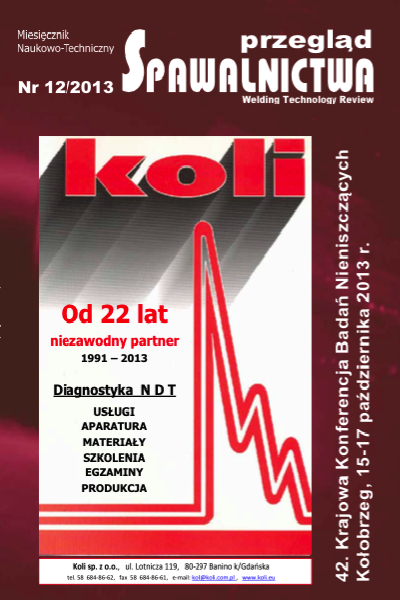Zastosowanie symulacji numerycznych w badaniach ultradźwiękowych detali kompozytowych
Main Article Content
Abstract
Symulacje numeryczne odgrywają coraz bardziej istotną rolę w badaniach nieniszczących. Są powszechnie wykorzystywane do opracowywania metod badawczych oraz potwierdzania ich skuteczności. Ich głównym celem jest wspomaganie analizy i interpretacji wyników badań. Artykuł pokazuje możliwości modelowania badań ultradźwiękowych na przykładzie badań zanurzeniowych detalu kompozytowego. W detalu wykonanym z kompozytu węglowo epoksydowego zlokalizowane są wady celowo wytworzone przez zalaminowanie cienkich, płaskich, prostokątnych wstawek teflonowych o znanych wymiarach. Wykonano ultradźwiękowe badania zanurzeniowe detalu i porównano je z wynikami symulacji przeprowadzonej dla utworzonego modelu numerycznego. Uzyskane wyniki dowiodły wysokiej wartości użytkowej symulacji numerycznej.
Application of numerical simulations of composite components ultrasonic testing
abstract
Numerical simulations play an increasingly important role in nondestructive testing. They are widely used for the development of testing methods to confirm their effectiveness. Their main purpose is to support the analysis and interpretation of the research results. The paper shows the possibilities of ultrasonic testing modeling on immersion testing of composite test piece example. In the component made of carbon-epoxy composite, intentionally created defects are located. The defects were made by lamination of thin, flat, rectangular teflon inserts of known dimensions. The ultrasonic immersion tests of the component are compared with the results of simulations carried out for the created numerical model. The results showed the high value of the numerical simulation.
Downloads
Article Details
Creative Commons CC BY 4.0 https://creativecommons.org/licenses/by/4.0/
Welding Technology Review (WTR) articles are published open access under a CC BY licence (Creative Commons Attribution 4.0 International licence). The CC BY licence is the most open licence available and considered the industry 'gold standard' for open access; it is also preferred by many funders. This licence allows readers to copy and redistribute the material in any medium or format, and to alter, transform, or build upon the material, including for commercial use, providing the original author is credited.
References
Mayer P., Kaczmar J.W.: Właściwości i zastosowania włókien węglowych i szklanych, Tworzywa sztuczne i chemia, 2008, nr 6.
Sarniak Ł., Wielgat M., Szwed M., Kurzydłowski K.J.: Ultradźwiękowe badania laminatów z zastosowaniem głowic wieloprzetwornikowych, 40KKBn, Warszawa 2011
Sarniak Ł.: Opracowanie metodyki wykrywania za pomocą badań
ultradźwiękowych wad powstających na etapie wytwarzania elementów kompozytowych stosowanych w lotnictwie, Politechnika Warszawska, Wydział Inżynierii Materiałowej, Warszawa, 2012
Gengembre n., Calmon P., Petillon O. and Chatillon S., Prediction of ultrasonic fields into composite multi-layered structures: homogenization approach for the direct field and statistical approach for the inner reflections, Review of Progress in QNDE, 22, 2003
Calmon P., Mahaut S., Chatillon S., Raillon R., CIVA: An expertise platform for simulation and processing NDT data, Ultrasonics 44, 2006
